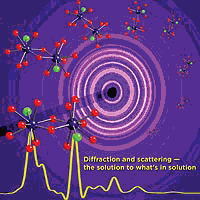Researchers from the U.S. Department of Energy's Argonne National Laboratory and from the University of Notre Dame, using XOR/BESSRC beamline 11-ID-B at the Argonne Advanced Photon Source (APS), have applied x-ray scattering techniques to determine how dissolved metal ions interact in solution. These findings will help researchers better understand how metal ions, such as those found in nuclear waste and other industrial processes, behave in the environment.
The results show that the ion structures are visible in solution and reveal their interactions with other ions. "The scientific community has long asked the question,'What happens to a metal ion in solution?'" said Suntharalingam "Skantha" Skanthakumar, Argonne senior scientific associate. "Direct measurement of metal correlations in solutions show long-range interactions and a strong correspondence to the structures in solution and in a solid state environment."
"We have been provided with additional structural and chemical insight into tetravalent actinide hydrolysis," said Lynda Soderholm, senior scientist and group leader in Argonne's Chemistry Division. "We discovered that the way atoms interact is transferable with a lot more detail than what was previously thought. Hydrolysis of dissolved metal ions is one of the most fundamental and important reactions in aqueous chemistry."
For this research, thin beams of high-energy x-rays from the APS were used to bombard the dissolved ions. When the x-rays scattered off the solutions, special charge-coupled device cameras equipped to detect the x-rays mapped out their two-dimensional pattern.
"Going forward, additional research is planned with thorium and other dissolvable materials across the periodic table," said Argonne postdoctoral researcher Richard E. Wilson. "The goal is to be able to predict reactions to metal contaminants and determine the chemistry that influences their transport in the environment."
Contact: L. Soderholm, ls@anl.gov.
See: Richard E. Wilson, S. Skanthakumar, Ginger Sigmon, Peter C. Burns, and L. Soderholm, "Structures of Dimeric Hydrolysis Products of Thorium," Inorg. Chem., 46(7), 2368 (2007). DOI: 10.1021/ic0617691
The original Argonne news item can be found here.
Funding for this project was provided by DOE's Office of Basic Energy Sciences, and Division of Chemical Sciences, Geosciences, and Biosciences.
Argonne is a U.S. Department of Energy laboratory managed by UChicago Argonne, LLC.

